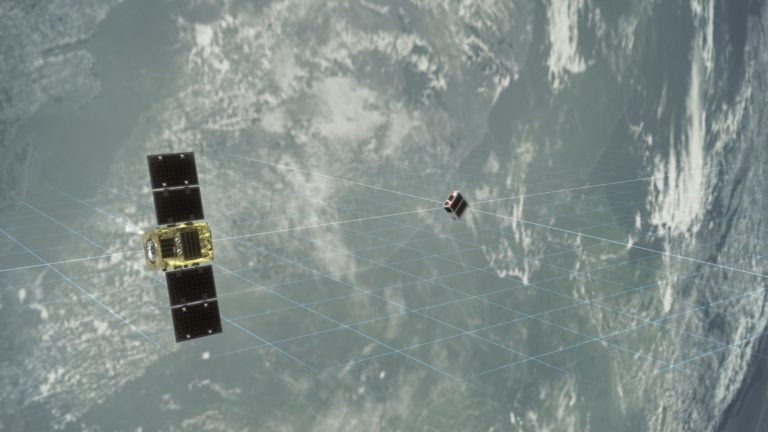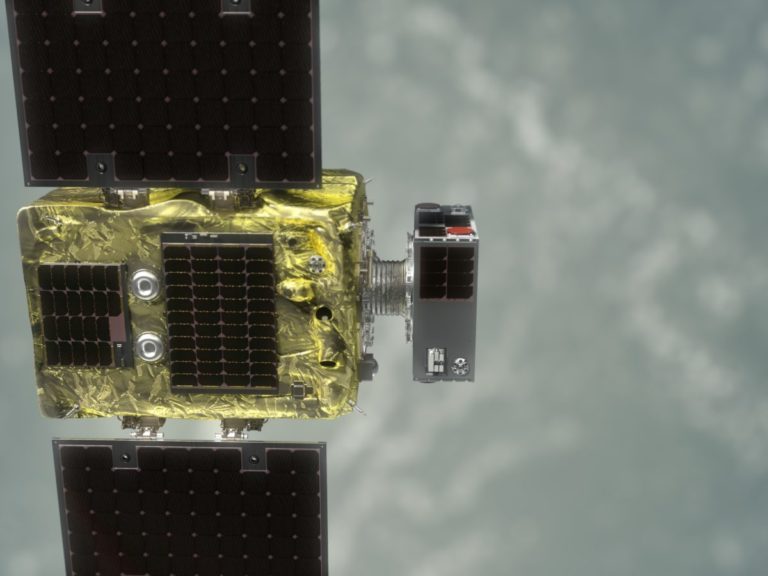ELSA-d: Leading the Way with Innovative Ground Station Solutions
Astroscale has joined forces with four leading satellite ground station providers to deliver our ELSA-d demonstration mission this year.
The Ground Segment partners SSC, KSAT, ATLAS Space Operations, and Viasat, along with Astroscale’s own ground station in Totsuka, Japan, have been hard at work to prepare for our debris removal demonstrations over the next few months.
So, what makes ELSA-d ground station special?
ELSA-d consists of two spacecraft: a Servicer spacecraft designed to capture and remove a defunct satellite, and a Client spacecraft that poses as the space debris. Each spacecraft requires a dedicated mission control system and a team of operators for the mission to be successful. Both are operated by Astroscale’s Mission Operations team at the National In-Orbit Servicing Control Centre (IOCC) at Satellite Applications Catapult on Harwell Campus in the United Kingdom.
Gene Fujii, Chief Engineer at Astroscale Holdings says, “ELSA-d will be a milestone moment in space engineering as we demonstrate the world’s first commercial debris removal mission; ground segment is one of these critical capabilities that is instrumental to our mission success.”

In space, minutes matter
For the Servicer to perform complex manoeuvres, such as capturing the Client with a magnetic docking plate — in both tumbling and non-tumbling scenarios— the control system via the ground stations must be in constant contact with the spacecraft for up to 20-30 minutes.
To deliver this extended period of continuous contact, Astroscale’s Ground Station team requires seamless connectivity as the spacecraft manoeuvres, and the connectivity changes from one ground station to the next. A total of 16 ground stations across 12 countries will support these efforts during the ELSA-d mission.
Astroscale UK’s Head of Ground Systems Engineering, Alberto Fernandez, explains, “A typical LEO mission’s connectivity ranges from 5-15 minutes, with 1 or 2 ground station providers in a couple of locations. We have sought 20-30mins connectivity with four partners in 16 locations. ELSA-d is performing complex demonstrations, that have never been done before, and we need a very reliable and unusually long chain of connectivity to provide a constant real-time data feed throughout the demonstrations.”
Fernandez adds, “A typical mission uses ground stations in the poles to maximize download contact times. We had to carefully select the ground stations and providers to maximize the duration of the constant contacts. We selected the stations by following the ground track of the spacecraft in addition to the poles.”

Using state-of-the-art visual imagery
The Astroscale Ground Station partners are also vital to help support Astroscale’s use of the Visual Camera (VISCAM) technology for navigation during ELSA-d’s demonstration manoeuvres. Using state-of-the-art image processing and machine learning algorithms, the image processing system will use real-time downloaded images of the two spacecraft to align, position and capture the debris satellite via a set of flight manoeuvres. These manoeuvres include client search, client inspection, client rendezvous — both non-tumbling and tumbling — and docking, collectively known as rendezvous and proximity operations.
Alexandra Gravereaux, Senior Ground Segment Engineer at Astroscale UK, says, “Reliable and continuous connectivity must be maintained with both of our spacecraft during each critical demonstration phase of the mission. We’re performing real-time, on-ground data processing from our cameras mounted on the satellites, performing image processing and calculating the manoeuvre plan using our flight dynamics to successfully capture the Client satellite.”
Partner perspectives
Brian Priar, Project Manager at SSC says, “Just like the mission itself, the ground segment solution is truly breaking new territory for modern space missions, and makes it evident that custom-made solutions are more accessible than ever before. From our antenna stations in Western Australia, Sweden, Canada, Thailand and two in Chile, SSC are ready to provide mission critical support for the demonstration phase. We are pleased to have already supported the ELSA-d LEOP and commissioning phases. Now, we are now looking forward to the main event.”
Kenneth Olafsson, Sales Director Asia at KSAT explains, “We have followed Astroscale for many years and were excited to partner for the ELSA-d mission. KSAT is providing mission critical support from our unique polar ground stations in the Arctic and Antarctica and will continue to provide seamless connectivity during the complex demonstration phase from these polar stations in combination with other parts of our interoperable global network. KSAT has developed and deployed a modern software-defined ground station architecture enabling us to grow together with Astroscale.”
Aaron Hawkins, Viasat’s Real-Time Earth Business Manager adds, “Space is a limited resource that as an industry we need to actively preserve. By joining Astroscale’s ELSA-d mission, we have an incredible opportunity to leverage our global Real-Time Earth ground stations—located across North and South America, Europe, Africa and Australia—to provide timely, reliable and seamless connectivity to meet the mission’s high-revisit requirements from the poles to mid-latitude stations.”
Mike Carey, Chief Strategy Officer at ATLAS Space Operations confirms, “This pioneering mission is very important to the growing orbital economy. The demands of the ELSA-d mission represent a tremendous opportunity for us to showcase our capabilities. Powered by our Freedom™ Platform, ATLAS Space Operations ground stations in Miami and Brewster, Washington are ready to deliver the reliability and responsiveness needed by Astroscale during proximity and rendezvous operations.”
Creating a frequency coordination network
The innovative technology, capability and sustainability goals of the ELSA-d mission helped support frequency coordination negotiations and built a solid foundation for future collaborations with government and legislative institutions.
Charity Weeden, Vice President for Global Space Policy at Astroscale U.S., says, “Any time you launch a satellite, you have to work through the regulatory process with at least one national government — in this case, we negotiated with 12, and in doing so established a precedent and an understanding for ground support licensing of future on-orbit servicing missions.”
From one piece of space debris, to multiple
John Auburn, Managing Director of Astroscale UK and Group Chief Commercial Officer, concludes, “Astroscale’s network of ground station providers will be critical to our commercial on-orbit servicing plans for the future. As we move forward, we will develop our capability to remove multiple pieces of debris during a single mission. We are continuously optimizing our efforts during this mission, and we will continue to innovate with our ground segment approaches as we roll out our End-of-Life Services in the coming years.”
Find out more about our ELSA-d mission.
Read the SpaceNews article our Ground Station efforts.

 Visit U.S. Site
Visit U.S. Site




